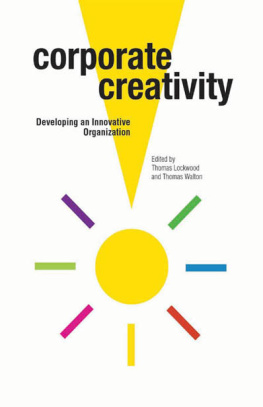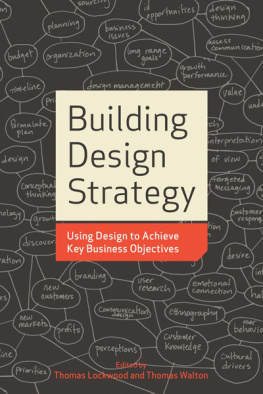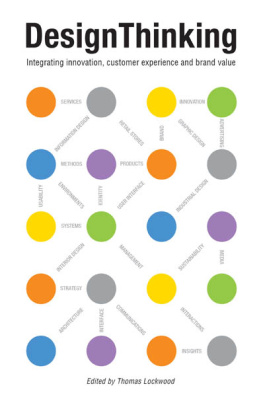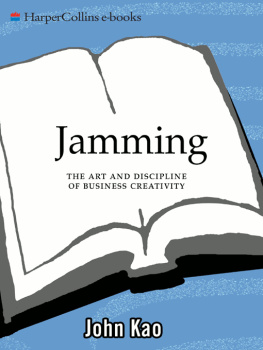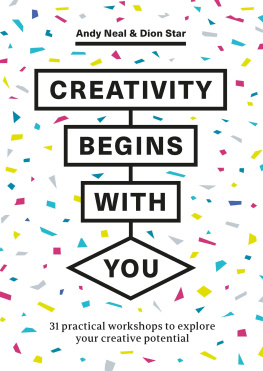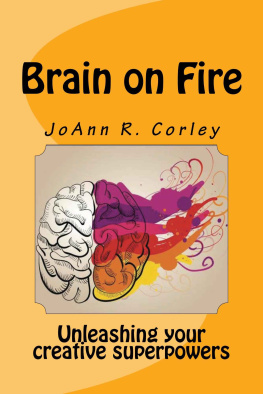Corporate Creativity
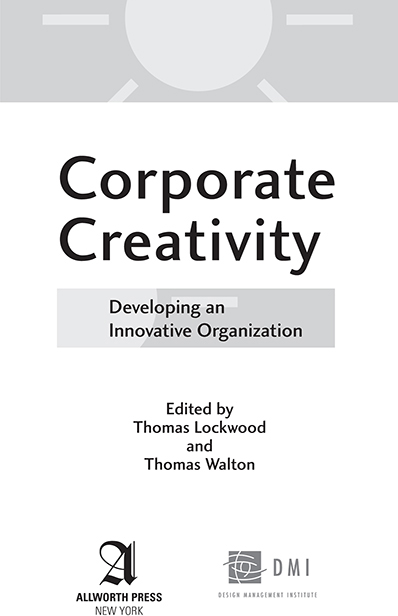
2008 Thomas Lockwood and Thomas Walton
All rights reserved. Copyright under Berne Copyright Convention, Universal Copyright Convention, and Pan-American Copyright Convention. No part of this book may be reproduced, stored in a retrieval system, or transmitted in any form, or by any means, electronic, mechanical, photocopying, recording, or otherwise, without prior permission of the publisher.
12 11 10 09 08 5 4 3 2 1
Published by Allworth Press
An imprint of Allworth Communications, Inc.
10 East 23rd Street, New York, NY 10010
Cover design by Jon Craine and Alan Lee
Interior design by Susan Ramundo
Page composition/typography by Susan Ramundo
ISBN-13: 978-1-58115-656-0
eBook ISBN: 978-1-58115-723-9
Library of Congress Cataloging-in-Publication Data
Corporate creativity: developing an innovative organization / edited by
Thomas Lockwood and Thomas Walton.
p. cm.
ISBN 978-1-58115-656-0
1. Creative ability in business. 2. Technological innovationsManagement.
3. Organizational learning. I. Lockwood, Thomas. II. Walton, Thomas.
HD53.C674 2009
658.4063dc22
2008050394
Printed in the United States of America
DEDICATION
This book is dedicated to all of the DMI members and
stakeholders around the world that have supported
the Institute since its founding in 1975.
Contents
Acknowledgments
We would like to express our gratitude to all of the authors whose work is included in this book. Your insights and professional input is greatly appreciated and makes editing this book a true pleasure. We would also like to acknowledge and thank all of the other authors who have contributed articles to DMIs Design Management Journal and Design Management Review publications over the years; they have made this body of knowledge the most extensive resource on design management in the world. We must also credit the outstanding work of the former president of DMI, Mr. Earl Powell, PhD (hon), who not only founded these publications and served as their publisher but was also responsible for the content from the beginning through 2005. His efforts have increased our understanding and advanced the role of design in business immensely.
Foreword
Imagination is more important than knowledge.
ALBERT EINSTEIN
WELCOME TO THE realm of corporate creativityand no, I do not intend that phrase as an oxymoron. A key objective for nearly every organization is to innovate and, in doing so, create meaningful value for its stakeholders and its customers. To that end, the successful organizations of the future will be those that make the most of the creativity of their employees and their partners. As Marty Neumeier so simply observes in The Designful Company, Creativity in its various forms has become the number-one engine of economic growth.
In the following chapters, we will take a closer look at the processes of discovery and invention with the aim of helping organizations create processes, artifacts, and experiences. We hope to provide a picture of the creative process in design and innovation, as well as in making meaning and value for customers. Todays open source systemsfrom Linux to the whole universe of wikis and social networking sitesmake it all the more possible to arrive at new solutions and answers to problems, and to tap into collective creativity.
Creativity is a mental activity, but it can also be part of a systems model. In fact, because it challenges traditional management processes and styles, creativity requires adaptive systems, and is dynamic. The domains of creativity lie in action and experimentation. As Will Rogers once said, Even if youre on the right track, youll get run over if you just stand there.
CREATIVITY FOR THE PUBLIC AND PRIVATE SECTORS
This book is meant to help draw out the creativity that lies hidden in businesses as well as in society at large, in the public as well as in the private sector. There are many ways to help an organization spark creative breakthroughs, and its never too late to start because creativity is a journey, not a destination. Developing your inner resources is part of the very fabric of creativity.
For most people, the idea of creativity is more associated with artists than with their daily work in business, but this could not be further from the truth. After all, the world is full of problems to be solved. Charles Eames once responded to the question, What are the boundaries of design? by asking, What are the boundaries of problems?
Learning to think creatively in one discipline opens the door to understanding creativity in other disciplines. Thats why our approach to creativity is integrative and multi-disciplinary. We want to help you solve small problems or even huge systems problems. I think everyone would like to learn how to tap more fully into their creative resources and see creativity applied to their daily business lives.
Were not trying to address the basic cognitive, physiological, and social issues of creativity in this book; rather, were hoping to develop a creative workforce. In this age of innovation, business requires a creative spark. Its no longer the province of the creatives at the advertising agency. As Robert and Michele Root-Bernstein have said, building creativity is about schooling the imagination. In the following pages you will find some polarity of ideas, and many examples of creative abrasion, informed play, and the blurring of disciplinary boundaries.
SECTIONS OF THIS BOOK
As Jeff Mauzy notes, although there is no one correct way to foster corporate creativity, we can study creativity as it occurs in individuals, coalitions and teams, and organizations. Mauzy also argues that creativity can be divided into three categories: creative thinking, climate, and action. With these two ideas in mind, weve organized this book into three sections: create, collaborate, and innovate. In the create section, we look into the topic of creative thinking and address the dynamics of personal and team creativity, how creativity works, and reinvigorating creativity in organizations. The collaborate section explores working in groups and climate and environment for innovation, including dynamics of the creative process. The third section, innovate, gives numerous examples of innovation and explores creative initiatives and business results.
A WEALTH OF OPINION
Twenty-six authors contributed to Corporate Creativity, myself included. Each article was originally published by DMI in the Design Management Journal or the Design Management Review, and they were chosen for their excellence and relevance to understanding creativity and innovation. By looking at ideas and stories, we hope to show how creativity can bring new products to market, transform businesses into brands, and help customers enjoy meaningful experiences.
The great thing about this approach is that we can present a range of ideas from across industries and disciplines. The results are not only diverse, opinionated, reflective, and thought-leading, but they also represent some of todays leading creative organizations.
This is the second book in our anthology series. Over the years, the Institute has published over 900 articles covering many aspects of design strategy, design leadership, design management, and of course, design as related to brand-building and innovation. I trust you will find the insights in this book beneficial to you, and I thank you for your interest in our work.
Next page
